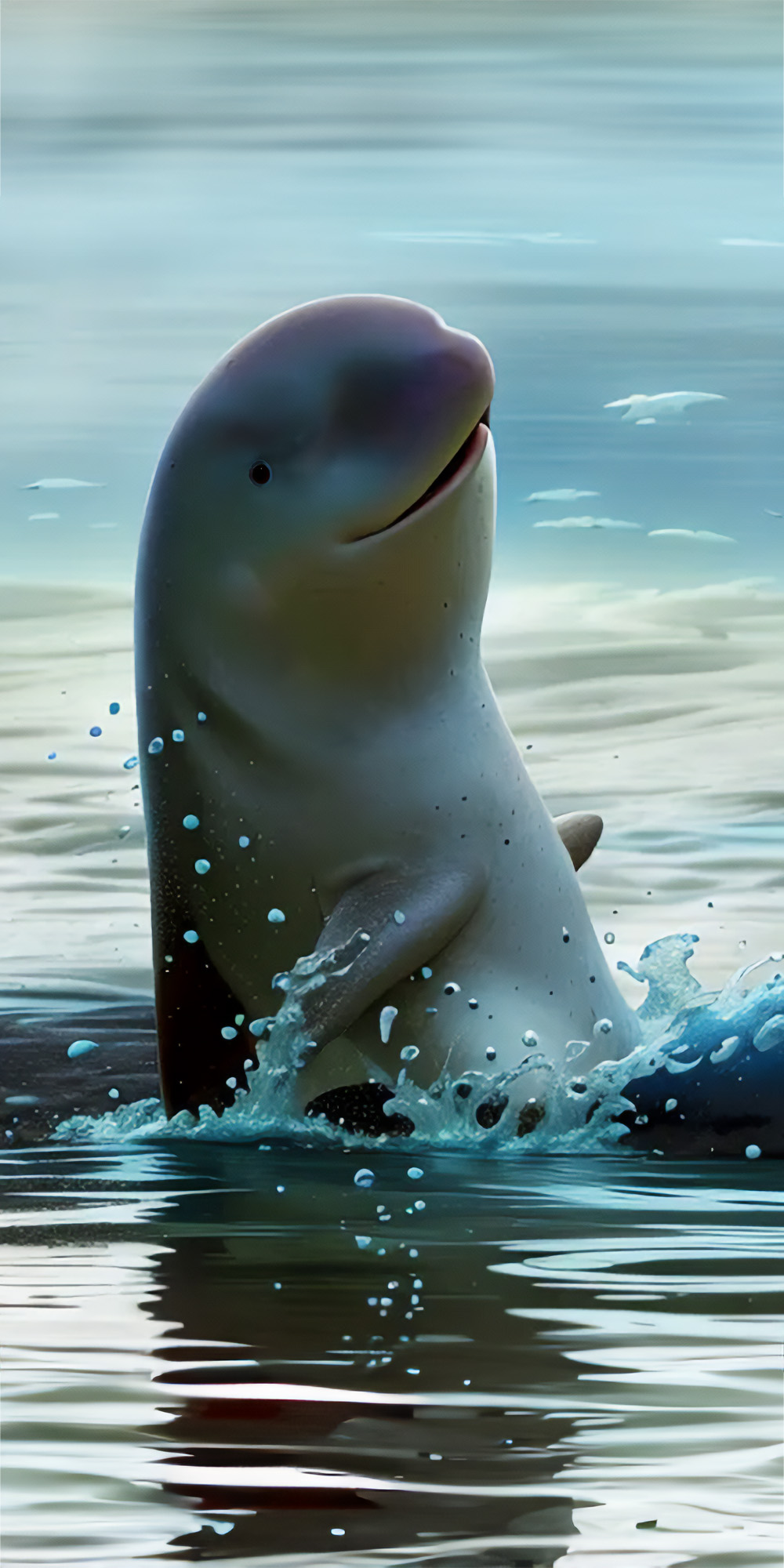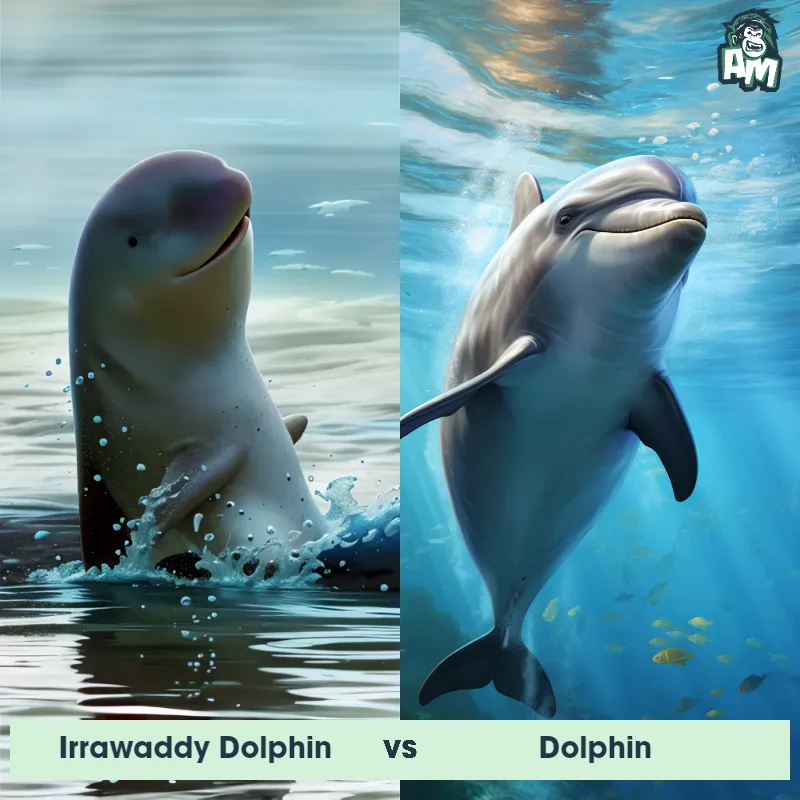The Irrawaddy Dolphin
The Irrawaddy Dolphin, also known as Orcaella brevirostris, is a medium-sized marine mammal found in the coastal waters of Southeast Asia. It can reach a length of up to 2.5 meters and weigh around 200 kilograms. The most distinctive feature of this dolphin is its rounded head with a short, stocky beak. It has a light gray to dark bluish-gray body, with a lighter underside. Unlike other dolphins, the Irrawaddy Dolphin has a flexible neck which allows it to turn its head in all directions. It is known for its playful behavior and is frequently observed swimming in groups.

| Irrawaddy Dolphin | |
|---|---|
| Size | Up to 8 feet (2.4 meters) in length |
| Weight | Up to 600 pounds (272 kilograms) |
| Speed | 20 mph (32 km/h) |
| Key Strength | Agile and fast swimmer |
| Biggest Weakness | Lack of aggression and low stamina |
| Scientific Name | Orcaella brevirostris |
| Family | Delphinidae |
| Habitat | Coastal areas, saltwater, freshwater rivers |
| Geography | Southeast Asia, particularly Myanmar and the Mekong River region |
| Diet | Fish, crustaceans, cephalopods |
| Lifespan | 20 years - 30 years |

The Irrawaddy Dolphin
The Irrawaddy Dolphin, also known as Orcaella brevirostris, is a medium-sized marine mammal found in the coastal waters of Southeast Asia. It can reach a length of up to 2.5 meters and weigh around 200 kilograms. The most distinctive feature of this dolphin is its rounded head with a short, stocky beak. It has a light gray to dark bluish-gray body, with a lighter underside. Unlike other dolphins, the Irrawaddy Dolphin has a flexible neck which allows it to turn its head in all directions. It is known for its playful behavior and is frequently observed swimming in groups.
Fun Fact: The Irrawaddy Dolphin has a peculiar way of catching fish by spitting water from its mouth, which creates a ring of bubbles to corral fish into a tight group, making it easier for the dolphin to catch them.
| Irrawaddy Dolphin | |
|---|---|
| Size | Up to 8 feet (2.4 meters) in length |
| Weight | Up to 600 pounds (272 kilograms) |
| Speed | 20 mph (32 km/h) |
| Key Strength | Agile and fast swimmer |
| Biggest Weakness | Lack of aggression and low stamina |
| Scientific Name | Orcaella brevirostris |
| Family | Delphinidae |
| Habitat | Coastal areas, saltwater, freshwater rivers |
| Geography | Southeast Asia, particularly Myanmar and the Mekong River region |
| Diet | Fish, crustaceans, cephalopods |
| Lifespan | 20 years - 30 years |
Irrawaddy Dolphin Matchups
We use AI to simulate matchups between the Irrawaddy Dolphin and other animals. Our simulation considers size, strength, and natural predatory behaviors to determine the most likely outcome.

Can't find the Matchup you want?
Create Your Own MatchupIrrawaddy Dolphin: Diet, Predators, Aggression, and Defensive Behaviors
What do Irrawaddy Dolphins eat?
Irrawaddy Dolphins primarily feed on various species of fish, crustaceans, and cephalopods. They are known to have a diverse diet, including mullet, catfish, shrimp, prawns, and squid. These dolphins are opportunistic feeders and will adapt their diet based on prey availability in their habitat.
Do Irrawaddy Dolphins have any predators?
Irrawaddy Dolphins do not have many natural predators due to their size and habitat. However, they may face threats from predators such as sharks, crocodiles, and larger marine mammals in certain regions. Additionally, human activities such as illegal fishing, pollution, and habitat degradation pose significant threats to their populations.
Are Irrawaddy Dolphins aggressive?
Irrawaddy Dolphins are known to be gentle and non-aggressive towards humans. They are curious animals and may interact with boats and swimmers in a playful manner. Unlike some other dolphin species, Irrawaddy Dolphins are not known to exhibit aggressive behaviors towards other marine creatures or humans.
Do Irrawaddy Dolphins fight?
Irrawaddy Dolphins are not territorial animals and rarely engage in physical fights with each other. Instead, they are more social and cooperative, often seen in small groups or pairs. These dolphins use a combination of vocalizations, body language, and echolocation to communicate and coordinate their activities, such as hunting and navigating.
How do Irrawaddy Dolphins defend themselves?
Irrawaddy Dolphins do not have many natural predators, but they have developed certain defense mechanisms to protect themselves when needed. When threatened, these dolphins can swim quickly to escape danger, use their agility to evade predators, and rely on their social structure to cooperate and coordinate defensive maneuvers.
What is the biggest weakness of Irrawaddy Dolphins in a fight?
The biggest weakness of Irrawaddy Dolphins in a fight would be their relatively small size compared to some larger predators they may encounter. While they are agile and swift swimmers, their size puts them at a disadvantage when facing larger and more powerful predators. Additionally, human-made threats such as entanglement in fishing gear and habitat destruction pose significant risks to their survival and well-being.
Fun Fact: Unlike most dolphins, the Irrawaddy Dolphin is primarily a freshwater species and can be found in rivers and estuaries, as well as in coastal waters, making it one of the few species of dolphins that can live in both saltwater and freshwater environments.
Fun Fact: The Irrawaddy Dolphin is known for its unique and distinctive vocalizations, which include a variety of clicks, whistles, and other sounds. These vocalizations play an important role in communication within the species, as well as in locating prey and navigating their environment.











